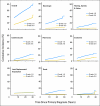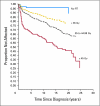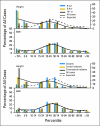Chronic disease in the Childhood Cancer Survivor Study cohort: a review of published findings
- PMID: 19364955
- PMCID: PMC2677922
- DOI: 10.1200/JCO.2008.21.1953
Chronic disease in the Childhood Cancer Survivor Study cohort: a review of published findings
Erratum in
-
Erratum.J Clin Oncol. 2021 Nov 10;39(32):3650. doi: 10.1200/JCO.21.02324. J Clin Oncol. 2021. PMID: 34739771 No abstract available.
Conflict of interest statement
Authors' disclosures of potential conflicts of interest and author contributions are found at the end of this article.
Figures














References
-
- Hudson MM, Mertens AC, Yasui Y, et al. Health status of adult long-term survivors of childhood cancer: A report from the Childhood Cancer Survivor Study. JAMA. 2003;290:1583–1592. - PubMed
-
- Bowers DC, Liu Y, Leisenring W, et al. Late-occurring stroke among long-term survivors of childhood leukemia and brain tumors: A report from the Childhood Cancer Survivor Study. J Clin Oncol. 2006;24:5277–5282. - PubMed
-
- Mulrooney DA, Dover DC, Li S, et al. Twenty years of follow-up among survivors of childhood and young adult acute myeloid leukemia: A report from the Childhood Cancer Survivor Study. Cancer. 2008;112:2071–2079. - PubMed
-
- Punyko JA, Mertens AC, Gurney JG, et al. Long-term medical effects of childhood and adolescent rhabdomyosarcoma: A report from the childhood cancer survivor study. Pediatr Blood Cancer. 2005;44:643–653. - PubMed
Publication types
MeSH terms
Substances
Grants and funding
LinkOut - more resources
Full Text Sources
Medical

